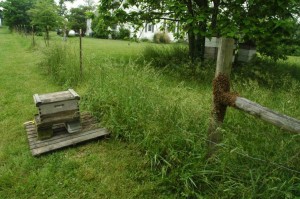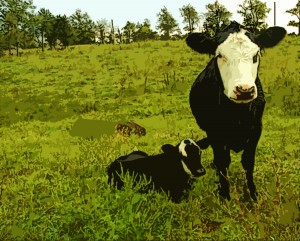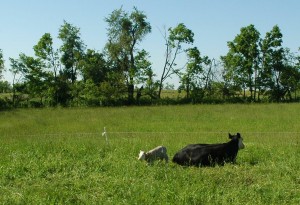I know the song has nothing to do with actual bees, but last night in a state of semi-delirium this was on repeat in my brain’s playlist, along with another primitive ditty of my own composition titled FUCK FUCK FUCK FUCK FUCKIN BEES (that is both chorus and verse. Catchy, no?).
So it was a bad evening in the beeyard, a very bad evening. Family out of town, at the beach. I stayed home to take care of farm duties. As much as I knew I would miss them, the idea of a week to myself had its appeal.
So I played golf til nearly dusk. Ah, the life. Then coming up the driveway, saw yet another cluster of bees hanging from a bush near the hives. I really didn’t know which hive had enough bees left for such a swarm but I knew I had to keep it from flying away.
I had gotten a little cocky about my routine (this would be my fourth swarm capture over the past couple weeks). Get a box, put a sheet under it, shake the bees into the box and watch their behavior. The queen was there and the workers were fanning, so I commenced Phase Two, shaking the bees into a new hive.
Phase Two. Yeah. This is where the complications set in. I had gotten in the habit of sweetening the lure of the new hive with a frame of honey that I “borrow” from an existing hive (the bees see it a little differently).
I do this in a hurry with little regard for proper beekeeper etiquette. Without bothering to light the smoker, I pop the lid off brusquely, find a fat honey-laden frame, grab it, and replace it with an empty frame. Bang the lid back on and I’m in business.
In this instance, it was near dusk and all the bees were home, and it was drizzling steadily. The hive was absolutely full of pissy bees. And then I got the replacement frame stuck/wedged and couldn’t get the lid back on. I had to struggle to get the frame down. Meanwhile, the entire hive went on major predator alert.
I’ve dealt with this but never on such a scale. Sometimes it just happens that the bees get ornery and bang at your headgear. They usually go right for the mouth. It’s a little unsettling but that’s what the suit and hood are for. This hive was “hot” beyond my wildest imaginings. As that dismal fact was dawning on me, I discovered yet another lapse in my preparations: I was in such a hurry that I had left a couple of gaps where I zip up my smock.
Aaaaaannnndddd…. DISASTER. Suddenly I had hundreds of bees on my bonnet (a phrase for which I have new-found admiration). Dozens of them were getting inside.
I suppose I must congratulate myself for recognizing that this was the rare moment when panicking was the best play. I dropped everything and started running, fast and far, and managed to shed most of the bees clinging to and stinging the outside of my suit.
Needless to say, I couldn’t run from the ones inside, buzzing loudly and stinging me about the head, and wrists, and up my back.
When I got a couple hundred yards away from the hive I tore off my gloves and suit at full gallop and then had to deal with the bees in my hair. I ran into the house and flapped and swatted and cursed — FUCK FUCK FUCK FUCK FUCKIN BEES– until I was finally pretty much rid of the bees. I had taken somewhere in the neighborhood of two dozen stings.
(This was pretty much a textbook case of how NOT to work with bees, but it could actually Have Been Worse. My decision to put on a pair of jeans was a last-minute call, and I don’t even want to think what would have happened had I not bothered to change out of shorts and had all the bare skin of my legs exposed…..)
I did my best to scrape the stingers out, sucked down a beer, and then returned to the scene of the crime, picking up my protective clothing, ever so sheepishly, and putting it back on en route way back to the hives.
I still had to get some kind of cover on the angry hive, sitting there open in the rain, which was coming down pretty well by this point. I did it. Wasn’t pretty. (Was anyone watching?) Then I had to get the swarm hive situated, make sure most of the stragglers were filtering back in, put the hive up on cinder blocks, and cover it.
All done. Night. Time for a couple tall WL Weller Special Reserves, and the contemplation of one’s own stupidity (and mortality). And, as this was by far the most stings I had taken at one time, to monitor myself for symptoms of anaphylactic shock.
I drifted off during the Nuggets-Lakers Game 7, and woke up a few times during the night. Still alive!









